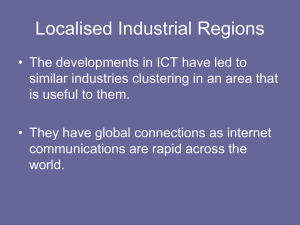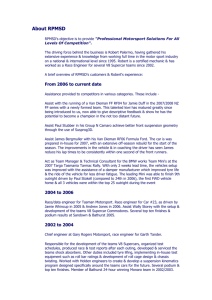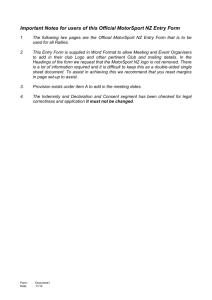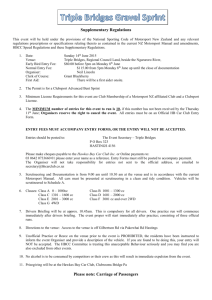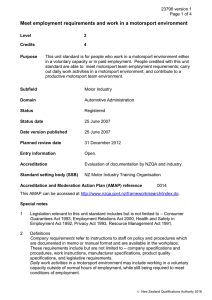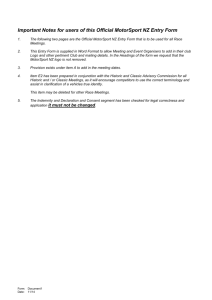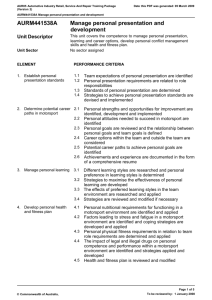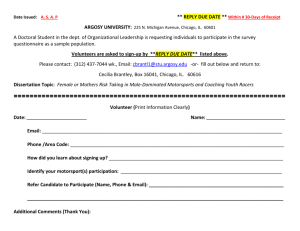Location, Location W
advertisement
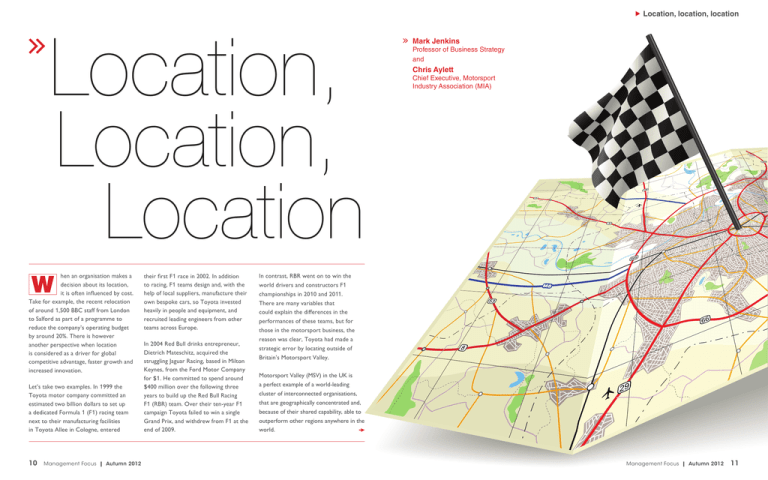
Location, location, location Location, Location, Location W hen an organisation makes a decision about its location, it is often influenced by cost. Take for example, the recent relocation of around 1,500 BBC staff from London to Salford as part of a programme to reduce the company’s operating budget by around 20%. There is however another perspective when location is considered as a driver for global competitive advantage, faster growth and increased innovation. Let’s take two examples. In 1999 the Toyota motor company committed an estimated two billion dollars to set up a dedicated Formula 1 (F1) racing team next to their manufacturing facilities in Toyota Allee in Cologne, entered 10 Management Focus | Autumn 2012 their first F1 race in 2002. In addition to racing, F1 teams design and, with the help of local suppliers, manufacture their own bespoke cars, so Toyota invested heavily in people and equipment, and recruited leading engineers from other teams across Europe. In 2004 Red Bull drinks entrepreneur, Dietrich Mateschitz, acquired the struggling Jaguar Racing, based in Milton Keynes, from the Ford Motor Company for $1. He committed to spend around $400 million over the following three years to build up the Red Bull Racing F1 (RBR) team. Over their ten-year F1 campaign Toyota failed to win a single Grand Prix, and withdrew from F1 at the end of 2009. Mark Jenkins Professor of Business Strategy and Chris Aylett Chief Executive, Motorsport Industry Association (MIA) In contrast, RBR went on to win the world drivers and constructors F1 championships in 2010 and 2011. There are many variables that could explain the differences in the performances of these teams, but for those in the motorsport business, the reason was clear, Toyota had made a strategic error by locating outside of Britain’s Motorsport Valley. Motorsport Valley (MSV) in the UK is a perfect example of a world-leading cluster of interconnected organisations, that are geographically concentrated and, because of their shared capability, able to outperform other regions anywhere in the world. Management Focus | Autumn 2012 11 Location, location, location “GSK could have chosen any location in the world to develop this capability yet it chose to connect with the exceptional and relevant expertise available in Motorsport Valley UK.” In a national survey by the Motorsport Industry Association, the UK motorsport industry was estimated to have annual sales exceeding £4.6 billion, of which over 66% was exported. The survey also revealed that more than 30% of firms spent over 15% of turnover on research and development. In addition to dominance in supplying F1 (67% of the 12 teams in 2012 are located in MSV), the industry is a major contributor to other global series, such as World Rallying, and NASCAR and IndyCar in the USA. Since the 1960s MSV has steadily evolved into a world-leading cluster, not simply through its dominance of this specialised marketplace, but through the interconnectedness and embeddedness of the firms, and institutions, that make up Motorsport Valley UK. Globally it makes the highest contribution to national GDP of any motorsport industry. This is why internationally-renowned automotive firms, such as Ferrari, Renault, Honda, Ford and Mercedes Benz, have established their own organisations or made equity investments and acquisitions, into this specialist, innovative, high performance engineering based cluster. The capability of the MSV cluster is not just limited to motorsport but acts as a technology and business catalyst in a wide variety of sectors including aerospace, 12 Management Focus | Autumn 2012 defence, education and electronics. For example, in the defence sector both F1 and World Rally Championship motorsport expertise has fed into the development of the Ocelot armoured vehicle, designed to replace the Snatch Land Rover, and in automotive WilliamsF1 are currently working in partnership with Jaguar on a hybrid supercar, the C-X75. One important aspect about a cluster that often makes it invisible, is that it is a mixture of regions, sectors and firms that build a unique knowledge base from the talented individuals that work within the cluster. Motorsport Valley is not just British people working in British firms. The best global talent from around the world are drawn to MSV because of the facilities and opportunities it offers them. As a consequence, it attracts significant inward investment. Currently none of the F1 teams in Motorsport Valley are wholly owned by British investors. Globallyowned organisations, utilising world-class international talent, have chosen to locate in this very specific region of the UK. Such knowledge and capability is not just of value to the motorsport sector. In 2011, pharmaceutical giant GlaxoSmithKline (GSK) announced a strategic partnership with the F1 team McLaren Racing focused on developing innovative business operations and high-tech research. A new state of the art learning facility, the ‘McLaren GSK Centre for Applied Performance’, will open in 2013. The aim is to build capabilities in business analytics, innovation and strategy modelling, to help drive improvements in clinical research processes by speeding up trial design and allowing real-time patient monitoring. GSK could have chosen any location in the world to develop this capability yet it chose to connect with the exceptional and relevant expertise available in Motorsport Valley UK. So what are the implications for firms and those making strategic decisions about location? The first is to place location in the context of a wider long-term strategy. In the mid-eighties and early nineties Ferrari located their research and development operation not in Italy but close to Guildford in Surrey, inside Motorsport Valley. This was regarded as essential to develop new technological capabilities. However Ferrari also recognised that ultimately their competitive success required one combined location for the organisation. So once they had built up these worldclass capabilities, they relocated back to Italy, where they remain today. The second point is that it is important not only to focus on the cost advantages, but also to identify those regions which can help build capabilities - to allow an organisation to harness a wider potential than its own resource base and build on the potential of globally superior clusters. Thirdly, it is important to weigh up the arguments for and against being in a cluster. One of the negative aspects can be staff being poached by competitors which is definitely a problem encountered by the motorsport teams. However, the positive side to this is that the local availability of high quality talent within a cluster is at a level that would be impossible to achieve anywhere else, so as companies grow they have the resources around them to support this growth and successfully exploit developing opportunities. Location remains a key decision for any organisation, but all too often such a decision is made purely on financial and opportunistic grounds. Rather than just focusing on cost reduction, it is important to also consider the knowledge and capabilities needed to deliver long-term competitive advantage. Motorsport Valley in the UK is a great story of global success and a perfect example of the enormous business value and potential of thinking strategically about business location. MF For further information please contact the co-author at mark.jenkins@cranfield.ac.uk or visit the Motorsport Industry Association website www.the-mia.com Management Focus | Autumn 2012 13
